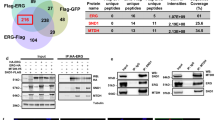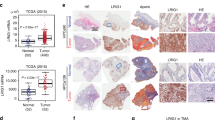Abstract
During progression of prostate cancer, cellular changes occur, leading to a transition from androgen-dependent to androgen-independent growth. One aspect of this transition is a switch from androgens to growth factors, like epidermal growth factor (EGF), as primary regulators of proliferation. We examined the involvement of REPS2/POB1 in this process. REPS2/POB1 is an EH domain-containing protein, reported to be involved in signalling via RalBP1 and to play a role in endocytosis of EGF receptors. Furthermore, the protein is relatively highly expressed in androgen-dependent as compared to androgen-independent human prostate cancer cell lines and xenografts. Next to the known REPS2/POB1 protein, an open reading frame encoding REPS2/POB1, with 139 additional amino-acid residues at the NH2-terminus, was cloned and found to be expressed in prostate cancer cells. Overexpression, by transient transfection, of both forms of REPS2/POB1 in prostate cancer cell lines, induced apoptosis within 48 h. At shorter time intervals after transfection, signalling towards a TPA response element luciferase reporter was found to be inhibited. From these experiments, it is concluded that REPS2/POB1, through its influence on the Ral signalling pathway, is involved in growth factor signalling. Decreased expression of REPS2/POB1 during progression of prostate cancer may therefore result in loss of control of growth factor signalling and consequently in loss of control of cell proliferation.
This is a preview of subscription content, access via your institution
Access options
Subscribe to this journal
Receive 50 print issues and online access
$259.00 per year
only $5.18 per issue
Buy this article
- Purchase on Springer Link
- Instant access to full article PDF
Prices may be subject to local taxes which are calculated during checkout




Similar content being viewed by others
References
Angel P, Imagawa M, Chiu R, Stein B, Imbra RJ, Rahmsdorf HJ, Jonat C, Herrlich P and Karin M . (1987). Cell, 49, 729–739.
Cantor SB, Urano T and Feig LA (1995). Mol. Cell. Biol., 15, 4578–4584.
Ceresa BP, Kao AW, Santeler SR and Pessin JE . (1998). Mol. Cell. Biol., 18, 3862–3870.
Chang GT, Blok LJ, Steenbeek M, Veldscholte J, van Weerden WM, van Steenbrugge GJ and Brinkmann AO . (1997). Cancer Res., 57, 4075–4081.
Coso OA, Chiariello M, Yu JC, Teramoto H, Crespo P, Xu N, Miki T and Gutkind JS . (1995). Cell, 81, 1137–1146.
Di Fiore PP and Gill GN . (1999). Curr. Opin. Cell. Biol., 11, 483–488.
Floyd S and De Camilli P . (1998). Trends Cell Biol., 8, 299–301.
Horoszewicz JS, Leong SS, Chu TM, Wajsman ZL, Friedman M, Papsidero L, Kim U, Chai LS, Kakati S, Arya SK and Sandberg AA . (1980). Prog. Clin. Biol. Res., 37, 115–132.
Ikeda M, Ishida O, Hinoi T, Kishida S and Kikuchi A . (1998). J. Biol. Chem., 273, 814–821.
Janssen T, Kiss R, Dedecker R, Petein M, Pasteels JL and Schulman C . (1995). Prostate, 27, 277–286.
Joneson T and Bar-Sagi D . (1999). Mol. Cell. Biol., 19, 5892–5901.
Jullien-Flores V, Dorseuil O, Romero F, Letourneur F, Saragosti S, Berger R, Tavitian A, Gacon G and Camonis JH . (1995). J. Biol. Chem., 270, 22473–22477.
Jullien-Flores V, Mahe Y, Mirey G, Leprince C, Meunier-Bisceuil B, Sorkin A and Camonis JH . (2000). J. Cell Sci., 113, 2837–2844.
Kariya K, Koyama S, Nakashima S, Oshiro T, Morinaka K and Kikuchi A . (2000). J. Biol. Chem., 275, 18399–18406.
Kozak M . (1987). Nucleic Acids Res., 15, 8125–8148.
Matsubara K, Hinoi T, Koyama S and Kikuchi A . (1997). FEBS Lett., 410, 169–174.
Nakashima S, Morinaka K, Koyama S, Ikeda M, Kishida M, Okawa K, Iwamatsu A, Kishida S and Kikuchi A . (1999). EMBO J., 18, 3629–3642.
Osada M, Tolkacheva T, Li W, Chan TO, Tsichlis PN, Saez R, Kimmelman AC and Chan AM . (1999). Mol. Cell. Biol., 19, 6333–6344.
Park SH and Weinberg RA . (1995). Oncogene, 11, 2349–2355.
Pruitt K and Der CJ . (2001). Cancer Lett., 171, 1–10.
Russell PJ, Bennett S and Strieker P . (1998). Clin. Chem., 44, 705–723.
van Steenbrugge GJ, van Uffelen CJ, Bolt J and Schroder FH . (1991). J. Steroid Biochem. Mol. Biol., 40, 207–214.
Vieira AV, Lamaze C and Schmid SL . (1996). Science, 274, 2086–2089.
Author information
Authors and Affiliations
Rights and permissions
About this article
Cite this article
Oosterhoff, J., Penninkhof, F., Brinkmann, A. et al. REPS2/POB1 is downregulated during human prostate cancer progression and inhibits growth factor signalling in prostate cancer cells. Oncogene 22, 2920–2925 (2003). https://doi.org/10.1038/sj.onc.1206397
Received:
Revised:
Accepted:
Published:
Issue Date:
DOI: https://doi.org/10.1038/sj.onc.1206397
Keywords
This article is cited by
-
Liver X receptor agonists exert antitumor effects against hepatocellular carcinoma via inducing REPS2 expression
Acta Pharmacologica Sinica (2023)
-
Identification a novel set of 6 differential expressed genes in prostate cancer that can potentially predict biochemical recurrence after curative surgery
Clinical and Translational Oncology (2019)
-
Whole-genome resequencing reveals genetic indels of feathered-leg traits in domestic chickens
Journal of Genetics (2019)
-
RLIP76 Targeted Therapy for Kidney Cancer
Pharmaceutical Research (2015)
-
Recurrent and novel SS18-SSX fusion transcripts in synovial sarcoma: description of three new cases
Tumor Biology (2012)



